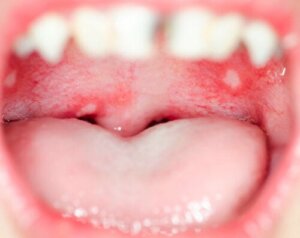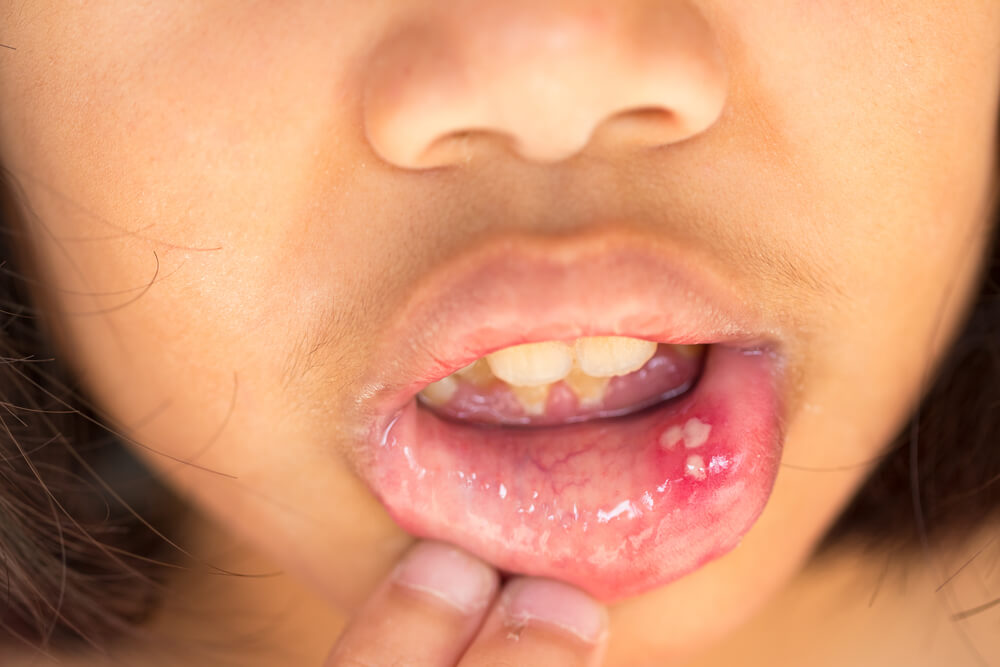Gingivostomatitis in Children: What You Should Know

Gingivostomatitis in children is a fairly common condition and is the primary infection of the herpes simplex virus.
The oral lesions that characterize the process and the discomfort suffered by the child are a cause for concern for their parents. Knowing what it is and how to relieve your little one will help you to accompany them in the best way possible.
Find out everything you need to know about this childhood ailment. Keep reading!
What is gingivostomatitis in children?
Gingivostomatitis is the clinical picture caused by the first infection of the herpes simplex virus in children. It appears in the form of annoying and painful lesions inside the mouth, which cause a lot of discomfort to the child.
In general, gingivostomatitis is a pathology typical of childhood, as most cases occur in children under 6 years of age. The virus easily reaches the child through saliva. For this reason, sharing toys, glasses, or any personal object becomes a possible route of transmission.
The development of the disease depends on several factors, some of which are specific to the infant’s body. In general, this pathology is associated with a decrease in the defenses or a deficit of vitamin B or C. Also, to the lack of good hygiene practices and the habit of putting hands or other dirty objects in the mouth.
Once the gingivostomatitis is overcome, the herpes simplex virus is stored in the child’s body and remains in a latent state. Under certain favorable circumstances (such as a decrease in defenses), it can reactivate and cause new manifestations, which are usually milder than the first ones.
Exposure to the sun or dry cold, trauma, infections, and other states of immunosuppression are predisposing factors for the reactivation of the virus. In these cases, the lesions are usually located on the lips or inside the mouth and look like a cluster of small blisters.

Symptoms of gingivostomatitis in children
Gingivostomatitis in children has very characteristic lesions, which are multiple painful sores inside the child’s mouth. In general, they’re located on the tongue, gums, cheeks, palate, and inner lips. But in some cases, they can also affect the mucosa of the throat.
At the beginning of the disease, these lesions look like red vesicles of liquid content. They then rupture and give rise to ulcerative lesions, which are large in size, covered by a yellowish-gray membrane, and surrounded by a very inflamed red halo. These ulcers are very painful and cause great discomfort to the child at all times.
In addition to the above, the clinical picture of gingivostomatitis in children is completed by the following symptoms:
- Persistent fever (greater than 38 °C)
- Excessive drooling
- Sore throat when swallowing
- Lack of appetite or refusal of food
- Headache
- Swelling of the gums, which look swollen, red, and bleed easily
- Bad breath
- Tiredness and general malaise
- Painful cervical lymph nodes
The treatment of gingivostomatitis in children
Gingivostomatitis in children is usually a painful and annoying process, both for the little one and for the parents. In general, it lasts between 10 and 18 days and resolves without treatment, spontaneously.
For this reason, all therapeutic measures are simply symptomatic. They consist of the use of medication and some home remedies to help the child feel better until the condition is resolved.
Seeing a pediatrician in order to evaluate the situation and determine the diagnosis is the first step to help the child, as there are other similar conditions that require other measures.
Once the diagnosis is confirmed, the pediatrician may prescribe some pharmacological treatment to improve the symptoms, such as paracetamol or ibuprofen. However, the child should never be medicated without the appropriate medical prescription.
In some cases, the professional may indicate the use of local anesthetic drugs to improve pain, especially during meals. In any case, their use is reserved for specific cases, as they’re not the safest option for use in children.
Finally, it’s important to take care of the child’s hydration and nutrition during the infectious process. Pain in the mouth may lead the child to refuse food, but they should continue with a sufficient intake of liquids. Especially if they receive oral analgesics.
Tips for good home care
In addition to the measures we have mentioned, we’re going to give you some recommendations to help your child to relieve the discomfort caused by gingivostomatitis:
- Offer fresh, soft foods. Ice cream, jelly, or applesauce are ideal choices to offer relief to sore mucous membranes. Avoid hard or very salty, acidic, or spicy foods.
- Ensure an abundant intake of water, especially cool water without additives.
- Help your child to rest. A few extra naps will help them relax and recover more easily.
- Keep their mouth clean with a good brushing of the teeth and tongue very gently.
- Avoid spreading the disease. The correct washing of your own and your child’s hands avoids the transmission of the virus to others. If the child attends a day-care center, they should stay at home for as long as their doctor indicates.

Complications of gingivostomatitis
Gingivostomatitis in children usually lasts about 2 weeks, with or without treatment. After that time, the lesions disappear without leaving sequelae.
But in some rare cases, the condition may become complicated, and taking some more measures becomes necessary.
As we’ve told you, the main inconvenience is dehydration due to the refusal of fluid intake. Other less frequent consequences are herpetic keratitis (eye condition) and paronychia (infection around the nails). Both occur due to accidental self-inoculation of the virus from oral lesions.
Finally, esophagitis, epiglottitis, pneumonitis, and encephalitis are much rarer complications, which usually occur in children with immune system deficiencies.
Therefore, it’s important to go to the emergency department if you notice that your child has any of the following symptoms:
- Very high and persistent fever that doesn’t go down with medication
- Convulsions
- Excessive decline, a tendency to sleep
- Accelerated respiratory rhythm
- Refusal to eat and drink liquids
- Absence of tears
- Decrease in the frequency of urination, or in the number of diapers changed during the day
- Diarrhea, stomach discomfort, or rashes
- Worsening or persistence of sores after 3 weeks
Accompanying the process is the key
Gingivostomatitis in children is a very annoying and painful condition. Little ones suffer a lot with so many sores in the mouth and this doesn’t allow them to go on with their normal life. At the same time, parents suffer because they don’t know how to offer relief.
But as we told you, this disease resolves after a few weeks and leaves no further damage. Therefore, it’s best to take your child to the pediatrician and follow their recommendations to help your child feel better.
Accompanying this process with patience and lots of love is also key. You’ll see that after a few days, the blisters in your child’s mouth will only be a bad memory.
Gingivostomatitis in children is a fairly common condition and is the primary infection of the herpes simplex virus.
The oral lesions that characterize the process and the discomfort suffered by the child are a cause for concern for their parents. Knowing what it is and how to relieve your little one will help you to accompany them in the best way possible.
Find out everything you need to know about this childhood ailment. Keep reading!
What is gingivostomatitis in children?
Gingivostomatitis is the clinical picture caused by the first infection of the herpes simplex virus in children. It appears in the form of annoying and painful lesions inside the mouth, which cause a lot of discomfort to the child.
In general, gingivostomatitis is a pathology typical of childhood, as most cases occur in children under 6 years of age. The virus easily reaches the child through saliva. For this reason, sharing toys, glasses, or any personal object becomes a possible route of transmission.
The development of the disease depends on several factors, some of which are specific to the infant’s body. In general, this pathology is associated with a decrease in the defenses or a deficit of vitamin B or C. Also, to the lack of good hygiene practices and the habit of putting hands or other dirty objects in the mouth.
Once the gingivostomatitis is overcome, the herpes simplex virus is stored in the child’s body and remains in a latent state. Under certain favorable circumstances (such as a decrease in defenses), it can reactivate and cause new manifestations, which are usually milder than the first ones.
Exposure to the sun or dry cold, trauma, infections, and other states of immunosuppression are predisposing factors for the reactivation of the virus. In these cases, the lesions are usually located on the lips or inside the mouth and look like a cluster of small blisters.

Symptoms of gingivostomatitis in children
Gingivostomatitis in children has very characteristic lesions, which are multiple painful sores inside the child’s mouth. In general, they’re located on the tongue, gums, cheeks, palate, and inner lips. But in some cases, they can also affect the mucosa of the throat.
At the beginning of the disease, these lesions look like red vesicles of liquid content. They then rupture and give rise to ulcerative lesions, which are large in size, covered by a yellowish-gray membrane, and surrounded by a very inflamed red halo. These ulcers are very painful and cause great discomfort to the child at all times.
In addition to the above, the clinical picture of gingivostomatitis in children is completed by the following symptoms:
- Persistent fever (greater than 38 °C)
- Excessive drooling
- Sore throat when swallowing
- Lack of appetite or refusal of food
- Headache
- Swelling of the gums, which look swollen, red, and bleed easily
- Bad breath
- Tiredness and general malaise
- Painful cervical lymph nodes
The treatment of gingivostomatitis in children
Gingivostomatitis in children is usually a painful and annoying process, both for the little one and for the parents. In general, it lasts between 10 and 18 days and resolves without treatment, spontaneously.
For this reason, all therapeutic measures are simply symptomatic. They consist of the use of medication and some home remedies to help the child feel better until the condition is resolved.
Seeing a pediatrician in order to evaluate the situation and determine the diagnosis is the first step to help the child, as there are other similar conditions that require other measures.
Once the diagnosis is confirmed, the pediatrician may prescribe some pharmacological treatment to improve the symptoms, such as paracetamol or ibuprofen. However, the child should never be medicated without the appropriate medical prescription.
In some cases, the professional may indicate the use of local anesthetic drugs to improve pain, especially during meals. In any case, their use is reserved for specific cases, as they’re not the safest option for use in children.
Finally, it’s important to take care of the child’s hydration and nutrition during the infectious process. Pain in the mouth may lead the child to refuse food, but they should continue with a sufficient intake of liquids. Especially if they receive oral analgesics.
Tips for good home care
In addition to the measures we have mentioned, we’re going to give you some recommendations to help your child to relieve the discomfort caused by gingivostomatitis:
- Offer fresh, soft foods. Ice cream, jelly, or applesauce are ideal choices to offer relief to sore mucous membranes. Avoid hard or very salty, acidic, or spicy foods.
- Ensure an abundant intake of water, especially cool water without additives.
- Help your child to rest. A few extra naps will help them relax and recover more easily.
- Keep their mouth clean with a good brushing of the teeth and tongue very gently.
- Avoid spreading the disease. The correct washing of your own and your child’s hands avoids the transmission of the virus to others. If the child attends a day-care center, they should stay at home for as long as their doctor indicates.

Complications of gingivostomatitis
Gingivostomatitis in children usually lasts about 2 weeks, with or without treatment. After that time, the lesions disappear without leaving sequelae.
But in some rare cases, the condition may become complicated, and taking some more measures becomes necessary.
As we’ve told you, the main inconvenience is dehydration due to the refusal of fluid intake. Other less frequent consequences are herpetic keratitis (eye condition) and paronychia (infection around the nails). Both occur due to accidental self-inoculation of the virus from oral lesions.
Finally, esophagitis, epiglottitis, pneumonitis, and encephalitis are much rarer complications, which usually occur in children with immune system deficiencies.
Therefore, it’s important to go to the emergency department if you notice that your child has any of the following symptoms:
- Very high and persistent fever that doesn’t go down with medication
- Convulsions
- Excessive decline, a tendency to sleep
- Accelerated respiratory rhythm
- Refusal to eat and drink liquids
- Absence of tears
- Decrease in the frequency of urination, or in the number of diapers changed during the day
- Diarrhea, stomach discomfort, or rashes
- Worsening or persistence of sores after 3 weeks
Accompanying the process is the key
Gingivostomatitis in children is a very annoying and painful condition. Little ones suffer a lot with so many sores in the mouth and this doesn’t allow them to go on with their normal life. At the same time, parents suffer because they don’t know how to offer relief.
But as we told you, this disease resolves after a few weeks and leaves no further damage. Therefore, it’s best to take your child to the pediatrician and follow their recommendations to help your child feel better.
Accompanying this process with patience and lots of love is also key. You’ll see that after a few days, the blisters in your child’s mouth will only be a bad memory.
All cited sources were thoroughly reviewed by our team to ensure their quality, reliability, currency, and validity. The bibliography of this article was considered reliable and of academic or scientific accuracy.
- Pérez Borrego, A., Guntiñas Zamora, M. V., & González Labrada, C. (2002). Valoración del estado inmunológico en niños con gingivoestomatitis herpética aguda. Revista Cubana de Estomatología, 39(1), 24-27.
- Salinas, Y. J., & Millán, R. E. (2008). Gingivoestomatitis herpética primaria: Conducta odontológica. Acta Odontológica Venezolana, 46(2), 219-226.
- Tovaru, S., Parlatescu, I., Tovaru, M., & Cionca, L. (2010). Gingivoestomatitis herpética primaria en niños y adultos. Quintessence: Publicación internacional de odontología, 23(4), 165-170.
- Gutiérrez-Gómez, C., Gargollo-Orvañanos, C., López-Mendoza, F. J., & Ferreira-Aparicio, F. E. (2021). Soy herpes no me operes por favor. Cirugía Plástica, 30(2), 117-122.
- Gleidis, Y., & García, M. (2021, October). GINGIVOESTOMATITIS HERPÉTICA RECURRENTE MÁS HERPES FACIAL. ASOCIACIÓN POCO FRECUENTE. In X Simposio Visión Salud Bucal y IX Taller sobre el Cáncer Bucal 2021.
- Daoud, Z., Ramos Amador, J. T., Morillo Gutiérrez, B., & Muñoz Hiraldo, E. (2018). Infecciones por virus del herpes simple 1 y 2. Guía-ABE. Tratamiento de las infecciones en Pediatría. Guía rápida para la selección del tratamiento antimicrobiano empírico. Madrid: Guía-ABE.
- Sanchez López, C. A. (2021). Prevalencia de lesiones en la mucosa oral en niños que acuden a un hospital nacional de Moyobamba en el periodo enero 2019–enero 2020.
- Gayretli Aydin, Z. G., Tanir, G., Genc Sel, C., Tasci Yıldız, Y., Aydin Teke, T., & Kaman, A. (2019). Encefalitis por herpes simple resistente al aciclovir en un niño tratado satisfactoriamente con el agregado de foscarnet: A propósito de un caso. Archivos argentinos de pediatría, 117(1), e47-e51.
- Hayajneh Carrillo, N., Tablado, M., & Carreño Beltrán, A. (2009). Rápida aparición de celulitis preseptal y herpes en niño atópico. Pediatría Atención Primaria, 11, e44-e44.
This text is provided for informational purposes only and does not replace consultation with a professional. If in doubt, consult your specialist.








